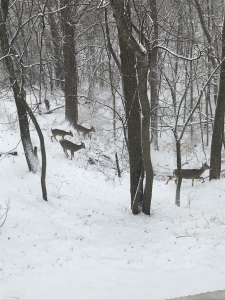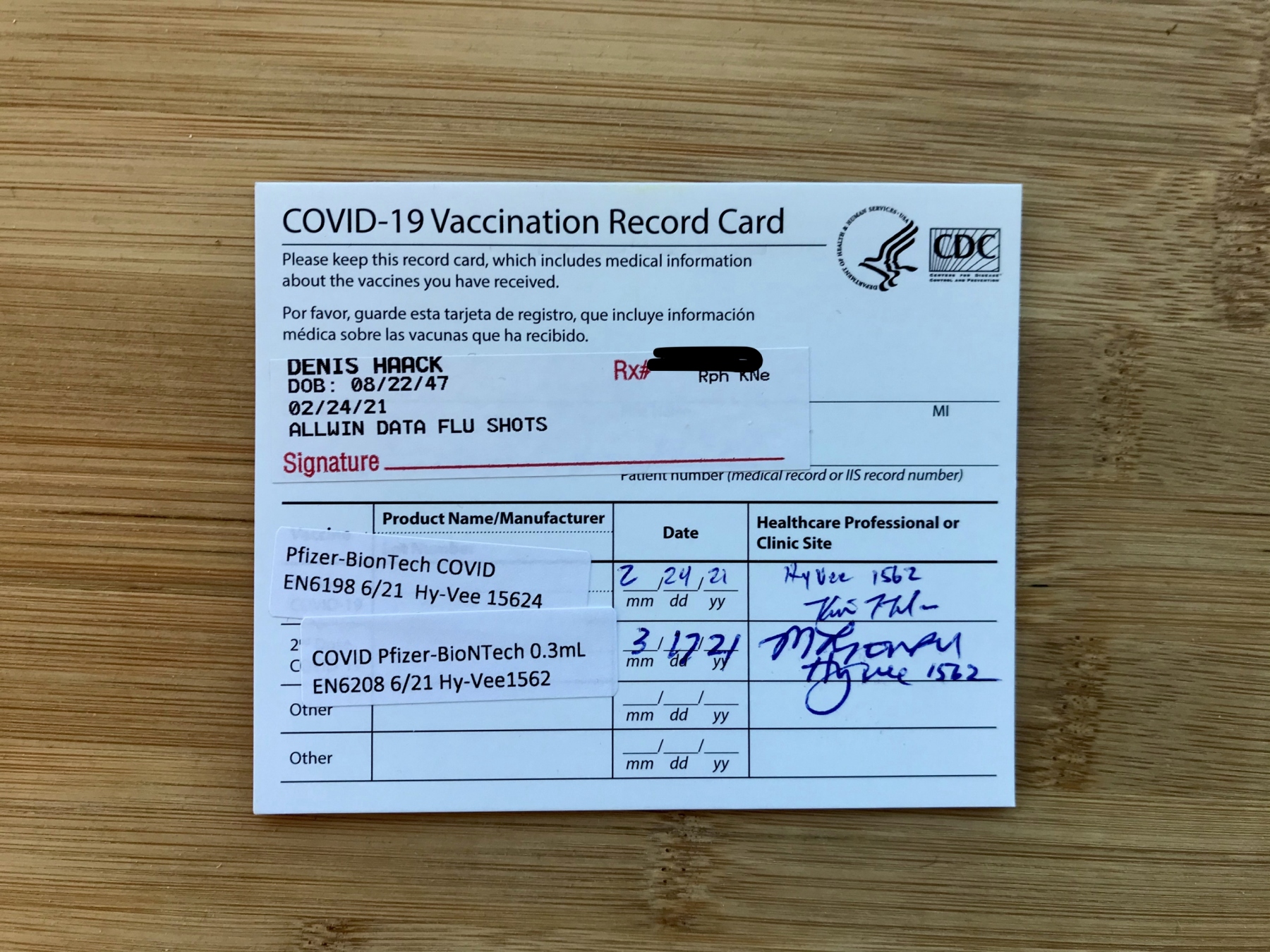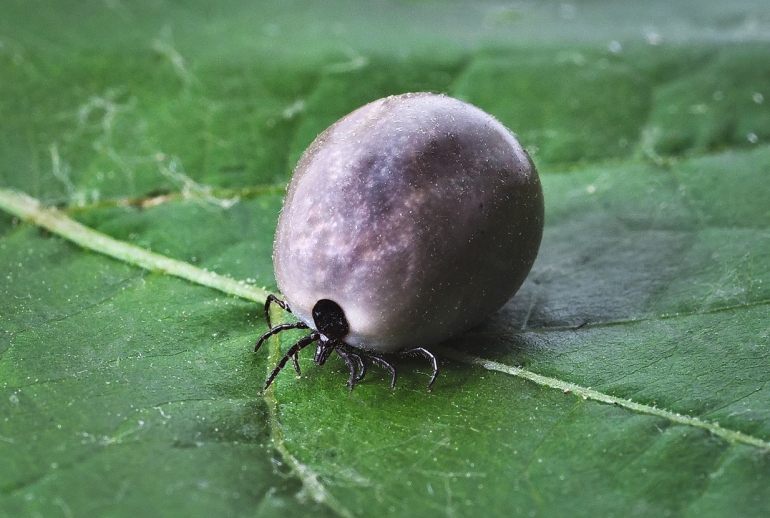Today I received my second Pfizer COVID vaccination.
As I sat in the pharmacy waiting area, I thought back to another epidemic I lived through. “From 1900 to 1960,” Daniel J. Wilson says, “there were polio epidemics almost every summer somewhere in the United States.” He should know—besides being a retired professor of history, he caught the disease at age five. In my elementary school there were several kids who had been infected by the poliovirus. Called infantile paralysis for good reason, they had survived but wore a heavy metal brace on a largely useless leg. I didn’t just hear about cases of the illness in the media, they sat next to me in class. I also remember how the polio vaccine was administered to us in the school gymnasium. Teachers herded us by class into long lines that wound around the gym to a station where public health nurses administered the shots. The smell of alcohol used to disinfect the spot of inoculation and the anxious nervousness that rippled up and down the lines meant teachers were kept occupied ministering to students who suddenly toppled over in a dead faint. Teachers said it was nothing to be embarrassed about, but they were wrong. It was embarrassing. The schoolyard bullies didn’t capitalize on that, however, because several of them keeled over just as they reached the nurse’s station in full view of the entire student body. Sometimes God’s grace is visible to all.
And it worked. The vaccination campaign, I mean. The numbers tell the story. In 1952 I was five years old; there were 57,879 cases of polio in the United States. In 1954 I was in second grade; there were 38,476 cases. In 1960, there were 3,190 cases and in 1998, 1 case. Since 2017, this horrible disease that occasionally kills and causes paralysis in children remains in circulation only in Pakistan, Nigeria and Afghanistan where efforts are underway to stop the spread. The poliovirus is not eradicated in America; rather we have achieved what epidemiologists call “herd immunity” so that it is unable to infect those who might be vulnerable.
Vaccine science has progressed wonderfully since Edward Jenner published work on the topic, coining the term “vaccine” in 1798. And the concentrated work on COVID by so many researchers in so many places around the globe during the pandemic of 2020 doubtlessly will serve to advance the field even more. Although increased speed is not always admirable or healthy, the decreased time it now takes scientists to produce a vaccine is a wonderful thing.
I grew up distrustful of science. It produced helpful things, true, but it also produced evolution. Scientists needed to set aside belief in the supernatural, I was taught—it’s called natural science for a reason—which meant their conclusions often challenged the truth of the Bible. I don’t remember anyone ever saying not to trust science and scientists; the repeated warnings simply ripened over time into distrust.
My negative assessment of modern science was sharply challenged when as a young man full of questions and doubts I discovered that Francis Schaeffer spoke highly of it. The early pioneers of modern science were Christians, he insisted, and in fact, it was the biblical worldview that made the entire enterprise possible. “Galileo, Copernicus, Francis Bacon, Kepler,” he said, “believed that the world was created by a reasonable God and therefore we could find out the order of the universe by reason” (p. 9). The same God who spoke through prophets and apostles to produce a trustworthy written word spoke in creation to call a trustworthy cosmos into existence. He is not arbitrary or distracted like pagan gods, and so scientists can trust that an orderly nature can be studied and that their research can result in true results. Creation is distorted by the fall, of course, and scientific knowledge must be verified as it develops, but scientific discovery brings glory to the Creator even if the scientist doing the research, is an unbeliever.
For Newton, Faraday and Maxwell, Rebecca McLaughlin says in “A (Very) Brief History of Christians in Science,” “science and faith went hand in hand, and studying God’s creation was an act of worship.” The widespread belief that science and Christianity are at odds is a recent development, and is badly mistaken. “I have long felt that there was a general impression in the non-scientific world,” Dr. McLaughlin continues, “that the scientific world believes Science has discovered ways of explaining all the facts of Nature without adopting any definite belief in a Creator. I have never doubted that that impression was utterly groundless.”
Over the last few decades American evangelicals have heard warnings about natural science, and the shrill rhetoric of the New Atheists has only increased the concern. This should not be, and the fearfulness expressed about COVID vaccination is very unfortunate. Modern science is a direct outgrowth of the Christian worldview and vaccines are good gifts of God. I am immensely grateful that Margie and I need not worry about our grandchildren being paralyzed by polio.
Some Christian friends have counselled caution because there is risk in being vaccinated. Of course, there is risk—this is a fallen world. There is risk in every medical procedure. I have an appointment to have my teeth cleaned next month, and there is risk involved. There is even risk in traveling to the place where the procedure will occur.
I received my shot at a pharmacy which my iPhone map says is 12 miles from our house. This is  Minnesota and our highways are not risk-free. On the way I noticed signs of a recent accident with a deer, the bloody carcass on the shoulder and bits of vehicle debris mixed in with the smear of blood on the pavement. We know there are whitetails around. Earlier this week I posted a picture taken from my office window of a lovely herd of five deer walking slowly out of the woods into our yard. They visit regularly, and we love seeing them. The Minnesota Department of Public Safety reports that in the years 2015-2019, there were 7,247 deer-vehicle crashes in the state, in which 121 people were seriously injured and 20 died. We didn’t happen to see deer on the roadway while we were driving to my inoculation, but we often have. We live in a world of risk, and as my example demonstrates, we all believe some risks are worth taking.
Minnesota and our highways are not risk-free. On the way I noticed signs of a recent accident with a deer, the bloody carcass on the shoulder and bits of vehicle debris mixed in with the smear of blood on the pavement. We know there are whitetails around. Earlier this week I posted a picture taken from my office window of a lovely herd of five deer walking slowly out of the woods into our yard. They visit regularly, and we love seeing them. The Minnesota Department of Public Safety reports that in the years 2015-2019, there were 7,247 deer-vehicle crashes in the state, in which 121 people were seriously injured and 20 died. We didn’t happen to see deer on the roadway while we were driving to my inoculation, but we often have. We live in a world of risk, and as my example demonstrates, we all believe some risks are worth taking.
Nearer the beginning of the COVID pandemic, Margie wrote an essay she called “Pandemic Wisdom.” She included this that is worth repeating here:
When the Black Plague reached Wittenberg, where Martin Luther lived and worked, he had this to say:
“I shall ask God mercifully to protect us. Then I shall fumigate, help purify the air, administer medicine, and take it. I shall avoid places and persons where my presence is not needed in order not to become contaminated and thus perchance infect and pollute others, and so cause their death as a result of my negligence. If God should wish to take me, he will surely find me and I have done what he has expected of me and so I am not responsible for either my own death or the death of others. If my neighbor needs me, however, I shall not avoid place or person, but will go freely.”
I am glad that the vaccination immunizes me from the coronavirus, and that as a result I will be able to be with my grandchildren more freely than has been possible over the last year. But I am even more pleased that in being vaccinated I am also ministering to my neighbors by helping to achieve herd immunity. And as a Christian, the call of Christ on my life requires me to accept risk in loving my neighbor, even my enemy. As Dietrich Bonhoeffer put it, “When Christ calls a man, he bids him come and die.” Which Bonhoeffer not only preached but demonstrated. In a world of risk, we can use common sense and the best medical advice available, as Luther advised, but in the end, loving our neighbor requires us to intentionally embrace risk—even to the point of death—in love, just as Jesus did in his life, suffering and death.
So, today I received my second COVID vaccination, and I am grateful. I am grateful that Margie and I have made it through the year of pandemic of 2020 without becoming infected. I am grateful for the numerous dedicated researchers and technicians that worked tirelessly in laboratories all over the world to develop vaccines in record time. I am grateful for the numerous pilots, truck drivers and other support personnel that work to transport the vials to centers across the country and the globe. I am grateful for the scores of volunteers and pharmacy workers who shepherd crowds of waiting people to the spot where we can be inoculated. I am grateful to take a risk in order to serve my neighbor in helping to achieve herd immunity so that COVID will no longer pose such a danger to those who are vulnerable. I am grateful that, being fully immunized, Margie and I will be able to attend in-person the service to celebrate the memory of our dear friends, Mel and Sue Awes, who were lost this year to COVID. And I am grateful beyond measure that in a few weeks I will be able to hug my grandchildren after a year of social distancing.
Sources: “Comparing the Polio and Coronavirus Epidemics” by Daniel J. Wilson in Post-Polio Health (Vol. 36, No. 2 Spring 2020) available online; Statistics on rates of paralytic poliomyelitis infection from Our World in Data online; The Church at the End of the 20th Century by Francis A. Schaeffer (Downers Grove, IL: InterVarsity Press; 1970); “A (Very) Brief History of Christians in Science” by Rebecca McLaughlin online (September 7, 2019) at BioLogos; Deer statistics from “Car Kill Deer Permits” by Sgt. Jesse Grabow of the Minnesota State Patrol in Northern Light Region (Wednesday, March 10, 2021) p. 2; Life Together: A discussion of Christian Fellowship by Dietrich Bonhoeffer, translated with an Introduction by John W. Doberstein (San Francisco, CA: Harper & Row, 1954) p. 8
Photo credit: taken by the author on his trusty iPhone



